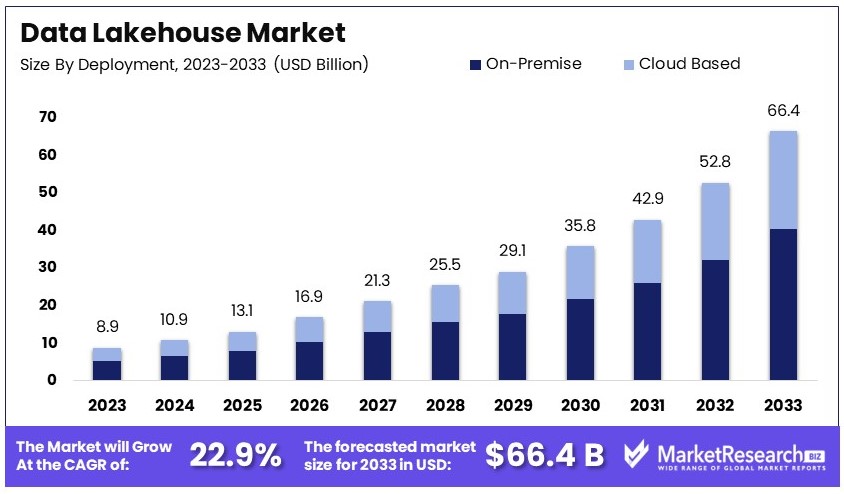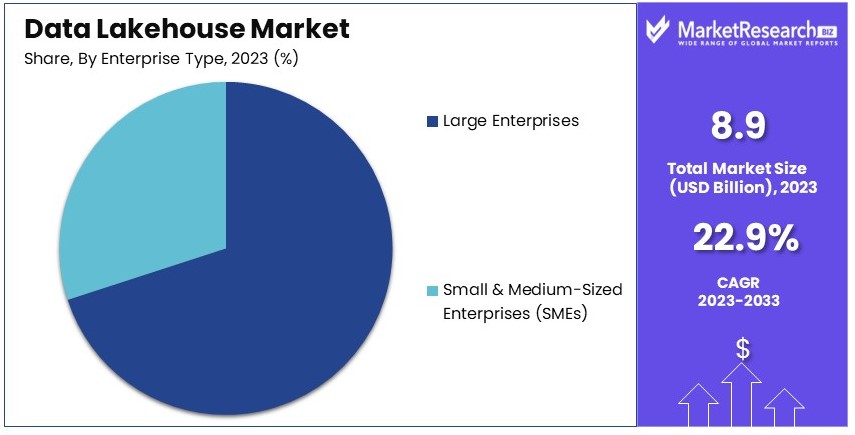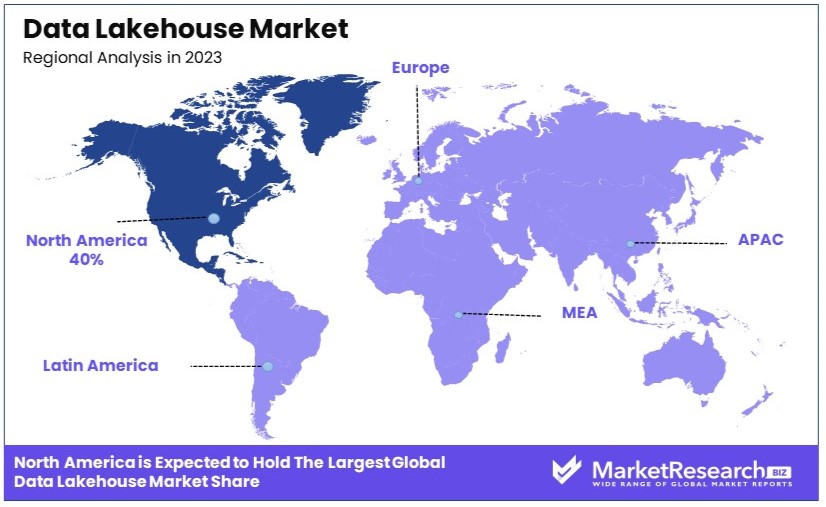
Data Lakehouse Market Report By Deployment (On-Premise, Cloud Based), By Enterprise Type (Large Enterprises, Small & Medium-Sized Enterprises (SMEs)), By Business Function (Marketing, HR, Operations, Finance), By Industry (IT & Telecom, BFSI, Retail & E-Commerce, Healthcare & Life Science, Manufacturing, Energy & Utilities, Others), By Region and Companies - Industry Segment Outlook, Market Assessment, Competition Scenario, Trends and Forecast 2024-2033
-
46858
-
May 2024
-
322
-
-
This report was compiled by Vishwa Gaul Vishwa is an experienced market research and consulting professional with over 8 years of expertise in the ICT industry, contributing to over 700 reports across telecommunications, software, hardware, and digital solutions. Correspondence Team Lead- ICT Linkedin | Detailed Market research Methodology Our methodology involves a mix of primary research, including interviews with leading mental health experts, and secondary research from reputable medical journals and databases. View Detailed Methodology Page
-
Quick Navigation
Report Overview
The Global Data Lakehouse Market size is expected to be worth around USD 66.4 Billion by 2033, from USD 8.9 Billion in 2023, growing at a CAGR of 22.9% during the forecast period from 2024 to 2033.
The Data Lakehouse Market combines the features of data lakes and data warehouses. It provides a single platform for storing and analyzing large volumes of data. Data lakehouses offer flexibility and scalability. They support both structured and unstructured data. The market is growing due to the rise of big data and advanced analytics.
Companies use data lakehouses for better decision-making. Key industries include finance, healthcare, and retail. Cloud-based solutions are becoming more popular. North America leads in adoption, with significant growth in Europe and Asia-Pacific. The market is driven by the need for real-time data processing and cost-effective storage solutions.

The data lakehouse market is poised for significant expansion, driven by the exponential growth of data and the need for efficient data management solutions. Each internet user generates approximately 1.7 megabytes of data per second. As of January 2024, there are 5.35 billion internet users worldwide, representing 66.2% of the global population. The digital universe now contains over 44 zettabytes of data, underscoring the massive volume of information that businesses must handle.
Data lakehouses, which combine the best features of data lakes and data warehouses, are becoming increasingly vital for organizations. They offer scalable storage and advanced analytics capabilities, enabling companies to derive valuable insights from their data. The ability to process both structured and unstructured data efficiently makes lakehouses a preferred choice for modern data architectures.
According to Capgemini, around one in four business executives report that their Big Data initiatives are profitable. This highlights the financial benefits that effective data management can bring. The growing number of data centers, particularly in the US, which has almost twice as many as the UK, Germany, and China combined, further supports the infrastructure needed for data lakehouse implementation.
Businesses are increasingly investing in data lakehouses to stay competitive. These solutions help organizations streamline their data workflows, reduce costs, and enhance decision-making processes. The integration of advanced technologies such as AI and machine learning within data lakehouses also provides a significant boost to their analytical capabilities.
In summary, the data lakehouse market is set to grow rapidly, driven by the surge in data generation and the need for robust data management solutions. Companies that adopt data lakehouses will likely see improved data handling, better insights, and enhanced profitability.
Key Takeaways
- Market Value: The Global Data Lakehouse Market is poised to surge from USD 8.9 Billion in 2023 to an estimated USD 66.4 Billion by 2033, with a projected CAGR of 22.9% during 2024-2033.
- Deployment Analysis: Cloud-based solutions dominate with 61% with scalability and cost efficiency.
- Enterprise Type Analysis: Large enterprises dominate with 70% due to advanced data needs and resources.
- Business Function Analysis: Operations dominate with 30%; process optimization and efficiency gains.
- Industry Analysis: BFSI dominates with 20%; regulatory compliance and data-driven insights.
- Dominant Region: North America dominated with 40%; advanced IT infrastructure and significant investments.
- High Growth Region: Europe to grow at 25% with digital transformation and regulatory compliance.
- Analyst Viewpoint: Strong growth potential in cloud solutions; competitive market with continuous innovation.
- Growth Opportunities: Expanding cloud services and AI integration; increasing demand for real-time analytics.
Driving Factors
Increasing Data Volume and Diversity Drives Market Growth
The Data Lakehouse Market is expanding due to the rising volume and variety of data organizations are collecting. Modern enterprises gather structured, semi-structured, and unstructured data from various sources like IoT solutions, social media, and enterprise applications.
For instance, Uber and Netflix leverage data lakehouses to manage and analyze the immense and diverse data generated from ride-sharing services and streaming platforms. These platforms need scalable and flexible storage and processing solutions, which data lakehouses provide effectively. The data center storage industry is experiencing rapid growth due to the increasing volume of data generated globally. As businesses continuously generate vast amounts of data, the demand for robust data lakehouse solutions grows, driving market expansion.
Demand for Real-Time Analytics and Decision-Making Drives Market Growth
The increasing demand for real-time analytics and decision-making is propelling the Data Lakehouse Market forward. Companies seek to leverage data to gain a competitive edge by making informed decisions quickly.
Data lakehouses enable the processing and analysis of data in real-time or near real-time. E-commerce giants like Amazon and Alibaba use data lakehouses to analyze customer behavior, inventory levels, and market trends in real-time. This capability optimizes operations and enhances customer experiences. The ability to make swift, data-driven decisions is critical for businesses, fueling the adoption of data lakehouses and driving market growth.
Convergence of Data Warehouses and Data Lakes Drives Market Growth
The Data Lakehouse Market is benefiting from the convergence of data warehouses and data lakes. Data lakehouses combine the strengths of traditional data warehouses, which manage structured data, with those of data lakes, which handle diverse data formats. This unified platform simplifies data architecture, reduces operational complexities, and enhances data management and analysis capabilities.
Financial institutions like JPMorgan Chase and Bank of America use data lakehouses to manage structured data from core banking systems and unstructured data from customer interactions and social media. This convergence supports a streamlined approach to data handling, boosting market growth.
Restraining Factors
Data Governance and Security Challenges Restrain Market Growth
Data governance and security issues are significant barriers to the growth of the Data Lakehouse Market. Managing diverse data formats, multiple data sources, and varying data sensitivity levels complicates the governance and security landscape.
Ensuring data quality, consistency, and compliance with regulations such as GDPR and HIPAA is challenging across the entire data lifecycle. Healthcare organizations, for example, face difficulties in implementing robust data governance and security measures when handling sensitive patient data. These complexities can deter organizations from adopting data lakehouses, thereby limiting market growth.
Skills and Expertise Gap Restrains Market Growth
The shortage of skilled professionals is a major obstacle to the growth of the Data Lakehouse Market. Implementing and managing data lakehouses requires expertise in data engineering, data architecture, cloud infrastructure, and data analytics.
However, there is a significant gap in the availability of professionals with these skills. Small and medium-sized enterprises (SMEs) often struggle to attract and retain the necessary talent to support their data lakehouse initiatives. This skills gap can hinder the widespread adoption of data lakehouses, particularly in organizations with limited resources or technical capabilities, thus restraining market growth.
Deployment Analysis
Cloud-Based Solutions Dominate with 61% due to Scalability and Cost Efficiency
The Data Lakehouse Market is segmented by deployment into on-premise and cloud-based solutions. Cloud-based solutions dominate this segment, accounting for 61% of the market. This dominance is due to the scalability, flexibility, and cost-efficiency offered by cloud-based deployments. Organizations are increasingly migrating to cloud platforms to manage their growing data volumes without the need for significant upfront investments in infrastructure. Cloud-based data lakehouses provide easy scalability, enabling businesses to expand their storage and processing capacities as needed.
Additionally, cloud solutions offer enhanced data security and compliance features, which are crucial for industries dealing with sensitive data, such as healthcare and finance. The integration capabilities of cloud-based data lakehouses with various data sources and analytics tools further drive their adoption. For example, companies like AWS, Google Cloud, and Microsoft Azure provide comprehensive data lakehouse services that streamline data management and analytics processes.
On-premise deployments, while offering greater control over data and infrastructure, face challenges in terms of scalability and higher costs. These solutions require significant investments in hardware and maintenance, which can be a barrier for many organizations. However, on-premise solutions remain relevant for enterprises with stringent data security and compliance requirements, where data sovereignty is a critical concern.
Enterprise Type Analysis
Large Enterprises Dominate with 70% due to Advanced Data Needs and Resources
The segmentation by enterprise type reveals that large enterprises dominate the Data Lakehouse Market, accounting for 70% of the market. Large enterprises possess the advanced data needs and financial resources necessary to implement and manage data lakehouse solutions effectively. These organizations often deal with massive amounts of data from various sources and require sophisticated analytics to drive strategic decision-making.
Large enterprises benefit from data lakehouses by integrating data from multiple departments and systems, enabling comprehensive data analysis and insights. The ability to handle diverse data types and provide real-time analytics is particularly valuable for large organizations in sectors like finance, healthcare, and retail. For instance, financial institutions like JPMorgan Chase and Bank of America use data lakehouses to manage vast datasets, ensuring regulatory compliance and enhancing customer experiences.
On the other hand, small and medium-sized enterprises (SMEs) face challenges in adopting data lakehouses due to limited resources and expertise. While SMEs can benefit from the scalability and flexibility of cloud-based solutions, the lack of skilled personnel to manage and analyze data can be a significant barrier. However, as cloud service providers continue to offer more user-friendly and cost-effective solutions, the adoption of data lakehouses among SMEs is expected to grow, contributing to overall market expansion.

Business Function Analysis
Operations Dominate with 30% due to Process Optimization and Efficiency Gains
Within the Data Lakehouse Market, the operations business function holds the largest share at 30%. Data lakehouses provide significant benefits to operational functions by enabling process optimization and efficiency gains. Organizations use data lakehouses to analyze operational data in real-time, leading to better decision-making and resource allocation. This is particularly important in industries such as manufacturing, logistics, and retail, where operational efficiency directly impacts profitability and customer satisfaction.
Data lakehouses facilitate the integration of data from various operational systems, such as supply chain management, inventory control, and production processes. By analyzing this data, businesses can identify bottlenecks, predict maintenance needs, and optimize workflows. For example, retail giants like Amazon and Walmart leverage data lakehouses to manage their extensive supply chains, ensuring timely deliveries and reducing operational costs.
Other business functions such as marketing, HR, and finance also benefit from data lakehouses, but their impact on market growth is less pronounced compared to operations. Marketing departments use data lakehouses for customer segmentation and targeted campaigns, HR for workforce analytics, and finance for financial forecasting and risk management. The ability to unify and analyze data across these functions contributes to the overall efficiency and competitiveness of organizations, further driving the adoption of data lakehouses.
Industry Analysis
BFSI Dominates with 20% due to Regulatory Compliance and Data-Driven Insights
The Banking, Financial Services, and Insurance (BFSI) sector is the dominant industry within the Data Lakehouse Market, accounting for 20% of the market. The BFSI sector relies heavily on data-driven insights for regulatory compliance, risk management, and customer service improvements. Data lakehouses provide the necessary infrastructure to handle large volumes of structured and unstructured data, enabling financial institutions to meet stringent regulatory requirements and enhance operational efficiency.
Data lakehouses allow BFSI organizations to integrate data from various sources, such as transaction records, customer interactions, and market data. This integration supports comprehensive risk assessments, fraud detection, and personalized financial services. For example, data lakehouses enable banks to analyze customer transaction patterns to identify potential fraud or to offer tailored financial products based on individual customer needs.
Other industries, including IT and telecom, retail and e-commerce, healthcare and life sciences, manufacturing, and energy and utilities, also contribute to the growth of the Data Lakehouse Market. Each industry leverages data lakehouses to address specific challenges and enhance operational capabilities. For instance, the healthcare industry uses data lakehouses for patient data management and predictive analytics, while the retail sector focuses on customer behavior analysis and inventory optimization. The diverse applications of data lakehouses across industries highlight their versatility and importance in driving market growth.
Key Market Segments
By Deployment
- On-Premise
- Cloud Based
By Enterprise Type
- Large Enterprises
- Small & Medium-Sized Enterprises (SMEs)
By Business Function
- Marketing
- HR
- Operations
- Finance
By Industry
- IT & Telecom
- BFSI
- Retail & E-Commerce
- Healthcare & Life Science
- Manufacturing
- Energy & Utilities
- Others
Growth Opportunities
Expanding Use Cases and Industry Adoption Offers Growth Opportunity
Data lakehouses are being adopted across various industries, including healthcare, finance, retail, manufacturing, and telecommunications. Organizations recognize the value of unified data management and analytics platforms. This widespread adoption is driving innovation and fostering the development of industry-specific solutions.
In healthcare, data lakehouses are used for precision medicine, clinical trial data management, and patient data analysis. In manufacturing, they enable predictive maintenance, supply chain optimization, and quality control. This broad industry adoption enhances the market's growth potential as it encourages the development of tailored solutions and new use cases.
Advancements in Machine Learning and Artificial Intelligence Offer Growth Opportunity
Integrating machine learning (ML) and artificial intelligence (AI) capabilities with data lakehouses is a significant growth driver. This combination allows organizations to leverage advanced analytics and ML models directly on their data, facilitating tasks such as predictive modeling, anomaly detection, and recommendation systems.
Companies like Netflix and Amazon use ML and AI on their data lakehouses to provide personalized recommendations based on viewing and purchase patterns. The ability to apply sophisticated analytics directly within data lakehouses enhances their value, driving increased adoption and market growth.
Trending Factors
Emergence of Open-Source and Cloud-Native Solutions Are Trending Factors
The rise of open-source data lakehouse platforms, such as Apache Hudi, Delta Lake, and Iceberg, is driving innovation and adoption in the market. Cloud service providers like AWS, Microsoft, and Google are introducing cloud-native data lakehouse solutions, simplifying deployment and management in the cloud.
For example, AWS Glue Data Brew and Google BigLake are cloud-native offerings that streamline data ingestion, preparation, and analytics. These developments make data lakehouse solutions more accessible and cost-effective, contributing to their growing popularity and market expansion.
Integration with Data Mesh Architectures Are Trending Factors
Data mesh is an emerging architecture paradigm focusing on decentralized data ownership and management. Data lakehouses support data mesh architectures by providing a centralized platform for data ingestion, storage, and processing while enabling distributed data ownership and governance.
This integration is gaining traction as organizations seek to improve data accessibility, agility, and scalability. By aligning with data mesh principles, data lakehouses enhance their appeal and functionality, driving adoption and positioning them as trending solutions in the data management landscape.
Regional Analysis
North America dominates with 40% market share due to high digital maturity and tech infrastructure.
North America holds a dominant position in the Data Lakehouse Market, capturing 40% of the market share. This dominance is driven by several key factors. The region has a high concentration of leading technology companies and a strong emphasis on digital transformation. Organizations in North America are early adopters of advanced data management and analytics solutions, including data lakehouses. Additionally, the presence of major cloud service providers like AWS, Microsoft Azure, and Google Cloud contributes to the widespread adoption of data lakehouses in the region.
Several factors contribute to North America's leading market share. The region has a robust technological infrastructure and a high level of digital maturity. Investments in big data and analytics are substantial, driven by industries such as finance, healthcare, and retail. Regulatory frameworks in North America also support data management and security, encouraging businesses to adopt advanced data solutions. The availability of skilled professionals and a strong emphasis on innovation further enhance the region's dominance in the market.

Regional Market Share
- Europe: Holds 25% market share, driven by regulatory compliance and digital transformation initiatives.
- Asia Pacific: Accounts for 20% market share, with rapid adoption in emerging economies and strong growth in the tech sector.
- Middle East & Africa: Has a 10% market share, with growing investments in digital infrastructure and data analytics.
- Latin America: Represents 5% market share, with increasing adoption of data solutions in finance and retail sectors.
Key Regions and Countries
- North America
- The US
- Canada
- Mexico
- Western Europe
- Germany
- France
- The UK
- Spain
- Italy
- Portugal
- Ireland
- Austria
- Switzerland
- Benelux
- Nordic
- Rest of Western Europe
- Eastern Europe
- Russia
- Poland
- The Czech Republic
- Greece
- Rest of Eastern Europe
- APAC
- China
- Japan
- South Korea
- India
- Australia & New Zealand
- Indonesia
- Malaysia
- Philippines
- Singapore
- Thailand
- Vietnam
- Rest of APAC
- Latin America
- Brazil
- Colombia
- Chile
- Argentina
- Costa Rica
- Rest of Latin America
- Middle East & Africa
- Algeria
- Egypt
- Israel
- Kuwait
- Nigeria
- Saudi Arabia
- South Africa
- Turkey
- United Arab Emirates
- Rest of MEA
Key Players Analysis
The Data Lakehouse Market is shaped by several key players, each bringing unique strengths and strategic positioning to the table. Companies like Teradata and Cloudera are known for their robust data management solutions, leveraging years of experience in data warehousing and analytics. Dremio stands out with its innovative approach to data lakehouses, offering advanced capabilities for data processing and querying.
Microsoft and AWS dominate with their extensive cloud infrastructures, providing scalable and flexible data lakehouse solutions. Snowflake's strong market influence comes from its cloud-native architecture, which simplifies data integration and management. Zaloni contributes with its data governance and management tools, enhancing data lakehouse efficiency.
Oracle Corporation and IBM Corporation leverage their broad enterprise customer base and comprehensive data solutions to maintain a strong market presence. Informatica adds value with its data integration and management expertise, supporting seamless data flows in data lakehouse environments. These companies collectively drive market growth through continuous innovation, strategic partnerships, and extensive service offerings.
In summary, the competitive landscape of the Data Lakehouse Market is characterized by the strategic initiatives and technological advancements of these key players, ensuring the sector's robust growth and evolution.
Market Key Players
- Teradata
- Cloudera
- Dremio
- Microsoft
- Snowflake
- Zaloni
- Oracle Corporation
- IBM Corporation
- Informatica
- AWS
- Other Key Players
Recent Developments
- May 2024: Tonic.ai, a San Francisco-based company, announced the launch of the world's first secure data lakehouse for LLMs, Tonic Textual. This platform is designed to eliminate integration and privacy challenges ahead of RAG ingestion or LLM training, which are major bottlenecks hindering enterprise AI adoption.
- May 2024: Dremio, a data lakehouse platform, integrated Apache Iceberg REST to promote a vendor-agnostic ecosystem. This integration allows users to access and manage data stored in Apache Iceberg tables using a RESTful API, making it easier to work with data across different systems and platforms.
- May 2024: A3logics, a data engineering company, expanded its AI and ML expertise. This expansion likely involved enhancing their data engineering capabilities to support the growing demand for AI and ML solutions across various industries.
- January 2024: IBM Storage Ceph was recognized as the ideal foundation for a modern data lakehouse. IBM Storage Ceph is an open-source, software-defined storage solution that provides scalable and reliable storage for data-intensive applications, making it well-suited for supporting the requirements of a data lakehouse architecture.
Report Scope
Report Features Description Market Value (2023) USD 8.9 Billion Forecast Revenue (2033) USD 66.4 Billion CAGR (2024-2033) 22.9% Base Year for Estimation 2023 Historic Period 2018-2023 Forecast Period 2024-2033 Report Coverage Revenue Forecast, Market Dynamics, Competitive Landscape, Recent Developments Segments Covered By Deployment (On-Premise, Cloud Based), By Enterprise Type (Large Enterprises, Small & Medium-Sized Enterprises (SMEs)), By Business Function (Marketing, HR, Operations, Finance), By Industry (IT & Telecom, BFSI, Retail & E-Commerce, Healthcare & Life Science, Manufacturing, Energy & Utilities, Others) Regional Analysis North America - The US, Canada, & Mexico; Western Europe - Germany, France, The UK, Spain, Italy, Portugal, Ireland, Austria, Switzerland, Benelux, Nordic, & Rest of Western Europe; Eastern Europe - Russia, Poland, The Czech Republic, Greece, & Rest of Eastern Europe; APAC - China, Japan, South Korea, India, Australia & New Zealand, Indonesia, Malaysia, Philippines, Singapore, Thailand, Vietnam, & Rest of APAC; Latin America - Brazil, Colombia, Chile, Argentina, Costa Rica, & Rest of Latin America; Middle East & Africa - Algeria, Egypt, Israel, Kuwait, Nigeria, Saudi Arabia, South Africa, Turkey, United Arab Emirates, & Rest of MEA Competitive Landscape C.H. Robinson Worldwide Inc., United Parcel Service of America Inc., DB Schenker, Core Logistic Private Limited, YUSEN LOGISTICS CO. LTD., FedEx, RLG, Deutsche Post AG, Kintetsu World Express Inc., SAFEXPRESS, Other Key Player Customization Scope Customization for segments, region/country-level will be provided. Moreover, additional customization can be done based on the requirements. Purchase Options We have three licenses to opt for: Single User License, Multi-User License (Up to 5 Users), Corporate Use License (Unlimited User and Printable PDF) -
-
- Teradata
- Cloudera
- Dremio
- Microsoft
- Snowflake
- Zaloni
- Oracle Corporation
- IBM Corporation
- Informatica
- AWS
- Other Key Players




